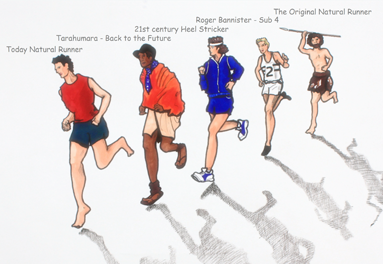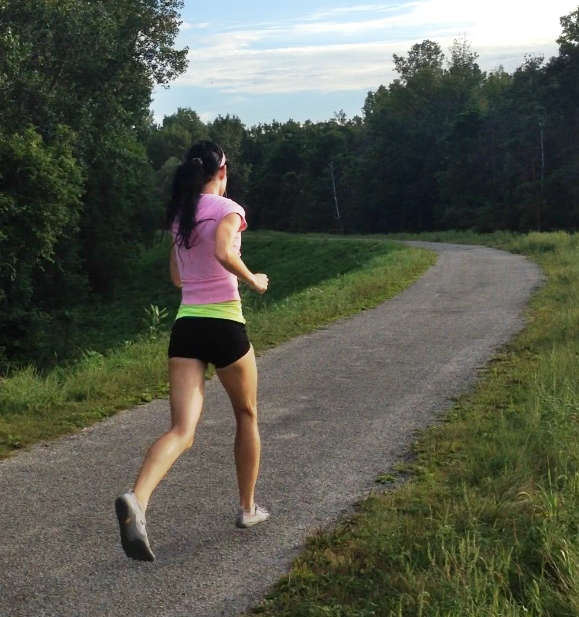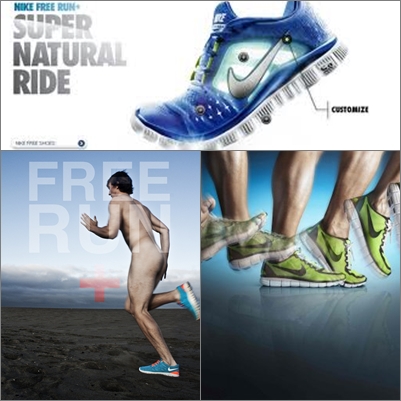Walk into any athletic store and you will find an abundance of minimalist shoes for running, but why all of a sudden?
Why all of a sudden are minimalist shoes for running in the spotlight, when for decades, runners were conditioned to believe running is dangerous and heavily cushioned shoes are needed for protection?
For example, the Nike Free’s are promoted as a barefoot running shoe with the slogan “free yourself” tacked on.
Free yourself from what? The stability and cushion elements that prevent the feet from functioning naturally and prevent us from running naturally.
Many shoe manufacturers have jumped on the minimalist bandwagon and encourage runners to run with less protection, but conveniently forget to mention how to run in a shoe that lacks protection.
Inexperience minimalist runners need to understand why heel striking needs to be avoided when running in barefoot-inspired footwear.
The Evolution of Minimalism
The Nike Free’s, along with the minimalist and barefoot running movement emerged after the publication of a compelling study by Dr.Lieberman et al., which suggested that since humans evolved as barefoot endurance runners, we must have adopted a forefoot strike over a heel strike because of the less impact factor.

Does this mean a forefoot strike prevents injury better than a heel strike when running in shoes?
Currently, the data is lacking on the effects of a forefoot strike on injury prevent because most studies on running injuries were on heel strikers.
But, we do know that one common way to get injured when running is by generating an impact transient, a force associated with heel striking, not forefoot running.
Impact Transient Requires Heel Protection in Heel Strikers
Heel striking is the predominant foot strike in joggers and the preferred footwear among these runners include a thick cushioned heel. Why? Because the impact transient generated at heel strike hurts and is why heel striking in a minimalist shoe is health-harming.
Despite excessive heel cushioning, the injury rate among recreational runners remains exceptionally high because cushioning does not eliminate the impact transient.
In a sense, the Harvard study was fundamental in running by showing that it’s not about barefoot running vs shod running, it’s about foot strike with respect to injury prevention. However, that is not what the Nike Free slogan implies.
The Nike slogan emphasizes more on the shoe providing a barefoot- experience rather than improving foot strike and learn to run safely.
Minimalist Shoes for Forefoot Strike Only

The theory is, which is actually becoming more of a fact, walking and running barefoot, or in minimalist footwear improves foot health and even biomechanics.
If you run barefoot, or in a minimalist shoe, you may want to do so with a forefoot strike because of the reduced impact factor. Makes sense.
Yet, Nike, along with the top shoe manufactures leave out an important message in their marketing for minimalist footwear. Nothing is mentioned about foot strike. But, does foot strike really matter in running? Absolutely.
Elite distance runners avoid heel striking for a reason, and with more data coming down the pipes, scientists may actually be able to settle the forefoot vs heel strike debate.
Understand the Purpose of a Minimalist Shoe to Avoid Injury
For now, many heel strikers continue to ditch their cushioned, heeled footwear to heel strike in a minimalist shoe, with no protection on the heel, which may have contributed to the spike in injury rates during the emergence of the minimalist/barefoot running movement. Perhaps, these runners were unfamiliar with Dr. Lieberman’s study and heel strike was maintained in a minimalist shoe.
The Take Home Message
We are quick to pin all the blame for running-related injuries on minimalist footwear. However, the running shoe industry are no saints in the matter as they provide no insight on how to run properly in their minimalist shoes.
There is a specific reason running shoe manufactures integrate a thick cushioned heel into the design of a running shoe, because they know about the peak forces associated with heel striking.
The thick, cushioned heel is most likely the only defense against the brute force at heel strike, why would shoe companies want to encourage runners to run without such protection?
More From Run Forefoot:
- Study: Heel Strikers May Injure More than Forefoot Strikers
- Switching From Heel Strike to Forefoot–Some Considerations
- Toe Running Causes Lower Leg Injury, Forefoot Running Does Not
- Alberto Salazar Says Run Like a Sprinter to be a Great Distance Runner
- Forefoot Running Shoes
Bretta Riches
BSc Neurobiology; MSc Biomechanics candidate, ultra minimalist runner & founder of RunForefoot. I was a heel striker, always injured. I was inspired by the great Tirunesh Dibaba to try forefoot running. Now, I'm injury free. This is why I launched Run Forefoot, to advocate the health & performance benefits of forefoot running and to raise awareness on the dangers of heel striking, because the world needs to know.
Latest posts by Bretta Riches (see all)
- Can You Run In Barefoot Shoes? Yes, But DON’T Heel Strike! - 21/07/2024
- Why Cushioned Running Shoes Are Really Bad for Your Feet - 19/07/2024
- Do Cushioned Running Shoes Cause Injuries? - 17/07/2024


Leave a Reply